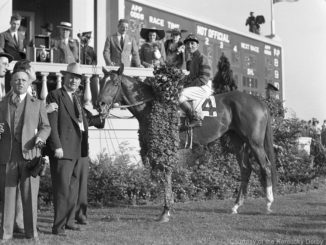
In addition to the blockbuster Arkansas Derby Day at Oaklawn Park, Saturday offers a virtual treat in the form of the “Kentucky Derby: Triple Crown Showdown.” The computer-simulated race, pitting the 13 Triple Crown champions against each other at Churchill Downs, will enliven the broadcast on NBC.
Because the outcome is dependent upon how the algorithms treat the data, it may or may not comport with the broad historical consensus. But it does offer a terrific opportunity to delve into the archives and marshal the arguments.
The Triple Crown winners can be categorized into four groups, primarily based upon how their classic sweep stacks up in the context of their overall careers. Their records versus elders, or as older horses themselves, are informative to a degree. That evidence is missing for a couple.
The opportunists
Although any 3-year-old capable of winning the Kentucky Derby (G1), Preakness (G1), and Belmont (G1) is exceptional, Sir Barton (1919), Omaha (1935), and Assault (1946) have lighter resumes among the all-time group. They arguably took advantage of lesser years to accomplish the feat, and still did not dominate their moderate crops. All three went on to productive 4-year-old campaigns, but even those highlights aren’t enough to raise their stature relative to the others. Thus without intending to sound pejorative, the word “opportunists” kept coming to mind.
Inaugural winner Sir Barton fits the description best, since he received a substantial weight break as a maiden in the Derby. Wiring the field under 112.5 pounds, he was getting a 6.5-pound pull from stablemate Billy Kelly and 9.5 pounds from co-highweight favorite Eternal. The other two jewels also had a slightly different character, with the Preakness at 1 1/8 miles and the 1 3/8-mile Belmont both shorter events in his day.
Omaha and Assault swept the crown under regular conditions, with all males toting 126 pounds at the three customary distances. But their records are blotchy with inconsistency, and questions linger if they could have been Triple Crown winners in deeper years.
The jurists
The next group represents champions who were clearly superior 3-year-olds, but then retired leaving unanswered questions to debate. Gallant Fox (1930), Count Fleet (1943), American Pharoah (2015), and Justify (2018) can make varyingly persuasive cases for themselves, so I’ve thought of them as “jurists.”
For sheer brilliance, Count Fleet commands the courtroom as a world record-setting champion juvenile and Belmont romper by a record margin and time. His competition was weak, however, and injury prevented him from proving himself versus elders. Still, his overwhelming dominance makes him the most impressive of this cohort.
Justify likewise bowed out without having faced older horses, but he has a higher burden of proof to meet. Unlike Count Fleet, he did not run off the screen in the classics, and he had no juvenile campaign to show greatness over time. While Justify’s fast-track to stardom after going unraced at two is obviously an historical marvel, it also meant that he only had to stay at that pinnacle in a condensed time frame. We’ll never know if he’d have preserved his perfect record through the summer and fall, never mind at four.
Gallant Fox progressed from two to three, going out on top as the undeniable star of his crop and 2-for-2 over older horses. Ironically, in his year, beating such smart contemporaries as Whichone and Questionnaire meant more than disposing of indifferent elders. That lack of a robust inter-generational reference point, and Gallant Fox’s unwillingness to do more than the minimum, undermine his case. “The Fox” has more charisma than his bare record, but style points only get you so far.
In contrast, American Pharoah puts forth the most well-rounded argument on paper, as a champion 2-year-old and conqueror of older horses in the Breeders’ Cup Classic (G1). Had he stuck around in 2016, “Pharoah” would have had the chance to defend his crown from two other champions – the older California Chrome and the younger Arrogate. And that would have gained him admission to the more exclusive inner circle.
The warriors
Four of the Triple Crown winners established themselves over the long haul. War Admiral (1937), Whirlaway (1941), Seattle Slew (1977), and Affirmed (1978) were battle-tested not only versus elders, but also took on the younger pretenders. These “warriors” distinguished themselves by shouldering high weights too. Seattle Slew toted 134 pounds to victory, while War Admiral and Affirmed carried as much as 132 pounds successfully. Whirlaway won under a maximum of 130 but at times lumped 132.
The quintessential warrior, Whirlaway hit the board in 56 of 60 starts and maintained championship form three consecutive seasons. “Mr. Longtail” was voted champion 2-year-old only in the Turf and Sport Digest poll, but reigned as an unambiguous champion at three and four. His younger challenger, Alsab, was a Hall of Famer himself. Whirlaway was arguably unlucky to lose to him twice in three meetings, but the clashes themselves add to his legacy.
Seattle Slew likewise gained stature in defeat, most notably when caught by the world-class stayer Exceller after an unsustainably fast pace in the 1 1/2-mile Jockey Club Gold Cup (G1). A champion at two, three, and four, “Slew” repelled his successor, Affirmed, in both meetings. Affirmed, also a champion all three seasons, won a similar laurel when rebuffing Spectacular Bid in the next Jockey Club Gold Cup.
War Admiral is the outsider of the group in that he was champion only at three, and didn’t beat any other all-time great. But he did continue his winning habits at four, until Seabiscuit spoiled the party.
The emperors
Wielding supreme authority in their prime, Citation (1948) and Secretariat (1973) are a class unto themselves as “emperors.”
Secretariat did not race beyond his 3-year-old season, but unlike those stuck in the “jurists” category, he presented an airtight case. Dirt or turf, short or long, fellow 3-year-olds or champion elders – at his best, Secretariat was simply sublime. It’s difficult to imagine a horse ever again approaching the standard of his 1973 campaign, with still-standing records in the Derby, Preakness, and Belmont (by an astronomical 31 lengths). Then toss in a world-record over the previous year’s dual classic winner, Hall of Famer Riva Ridge, among an all-star cast in the Marlboro Cup (G1); blitzing in a turf course record in the Man o’War (G1); and clinching champion turf horse honors in the Canadian International (G2). Oh, and he was Horse of the Year as a 2-year-old also.
Secretariat’s Achilles’ heel was that he didn’t always fire his best. That’s the very angle that Citation partisans can cite in his favor – “Big Cy” could be relied upon to deliver, winning 27 of 29 starts in his championship 2- and 3-year-old seasons that offer direct comparisons. He too beat fellow Hall of Famers in the older Armed as well as his contemporary Coaltown. Although Citation suffered more losses as an older horse, he was literally shouldering a burden that Secretariat never did, carrying 130 pounds or more, not to mention trying to recover his old spark after a year on the sidelines.
How does one compare such all-time greats in a theoretical head-to-head? If Secretariat were greatness in its dazzling array, Citation was greatness distilled into its silkiest smoothness. The simple test of the clock will say Secretariat was faster, but if your life depended on a horse’s performance on any random day, you’d probably make Citation your insurance policy.




Get real, it’s already decided that Secretariat will win. The fix is in. My choice: Seattle Slew. His breaking through a wall of horses to gain position after his disastrous break was the best Derby win ever. Secretariat would have had to kill Slew to get past him if they raced against each other.